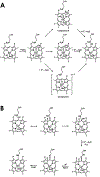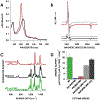Cytochrome P460 Cofactor Maturation Proceeds via Peroxide-Dependent Post-translational Modification
- PMID: 37338957
- PMCID: PMC10431212
- DOI: 10.1021/jacs.3c03608
Cytochrome P460 Cofactor Maturation Proceeds via Peroxide-Dependent Post-translational Modification
Abstract
Cytochrome P460s are heme enzymes that oxidize hydroxylamine to nitrous oxide. They bear specialized "heme P460" cofactors that are cross-linked to their host polypeptides by a post-translationally modified lysine residue. Wild-type N. europaea cytochrome P460 may be isolated as a cross-link-deficient proenzyme following anaerobic overexpression in E. coli. When treated with peroxide, this proenzyme undergoes maturation to active enzyme with spectroscopic and catalytic properties that match wild-type cyt P460. This maturation reactivity requires no chaperones─it is intrinsic to the protein. This behavior extends to the broader cytochrome c'β superfamily. Accumulated data reveal key contributions from the secondary coordination sphere that enable selective, complete maturation. Spectroscopic data support the intermediacy of a ferryl species along the maturation pathway.
Figures












Similar articles
-
Cytochromes P460 and c'-β: exploiting a novel fold for multiple functions.J Biol Inorg Chem. 2025 Mar;30(2):181-207. doi: 10.1007/s00775-025-02102-3. Epub 2025 Feb 26. J Biol Inorg Chem. 2025. PMID: 40009202 Free PMC article. Review.
-
Cytochrome c'β-Met Is a Variant in the P460 Superfamily Lacking the Heme-Lysyl Cross-Link: A Peroxidase Mimic Generating a Ferryl Intermediate.Biochemistry. 2020 Feb 11;59(5):704-716. doi: 10.1021/acs.biochem.9b00810. Epub 2020 Jan 14. Biochemistry. 2020. PMID: 31887031
-
Structural Characterization of Cytochrome from an Ammonia-Oxidizing Bacterium.Biochemistry. 2022 Apr 5;61(7):563-574. doi: 10.1021/acs.biochem.1c00640. Epub 2022 Mar 22. Biochemistry. 2022. PMID: 35315646
-
Heme P460: A (Cross) Link to Nitric Oxide.Acc Chem Res. 2020 Dec 15;53(12):2925-2935. doi: 10.1021/acs.accounts.0c00573. Epub 2020 Nov 12. Acc Chem Res. 2020. PMID: 33180458 Free PMC article.
-
Covalent cofactor attachment to proteins: cytochrome c biogenesis.Biochem Soc Trans. 2005 Aug;33(Pt 4):792-5. doi: 10.1042/BST0330792. Biochem Soc Trans. 2005. PMID: 16042600 Review.
Cited by
-
Detection and characterization of a compound 1 species from the c-type heme enzyme cytochrome c'β.Chem Sci. 2025 Jul 28;16(33):15265-15275. doi: 10.1039/d5sc03378k. eCollection 2025 Aug 20. Chem Sci. 2025. PMID: 40735684 Free PMC article.
-
Double crossed? Structural and computational studies of an unusually crosslinked haem in Methylococcus capsulatus cytochrome P460.Chem Sci. 2025 Aug 8. doi: 10.1039/d5sc04213e. Online ahead of print. Chem Sci. 2025. PMID: 40822104 Free PMC article.
-
Cytochromes P460 and c'-β: exploiting a novel fold for multiple functions.J Biol Inorg Chem. 2025 Mar;30(2):181-207. doi: 10.1007/s00775-025-02102-3. Epub 2025 Feb 26. J Biol Inorg Chem. 2025. PMID: 40009202 Free PMC article. Review.
-
Outer coordination sphere influences on cofactor maturation and substrate oxidation by cytochrome P460.Chem Sci. 2023 Jul 19;14(31):8295-8304. doi: 10.1039/d3sc02288a. eCollection 2023 Aug 9. Chem Sci. 2023. PMID: 37564409 Free PMC article.
References
-
- Macek B; Forchhammer K; Hardouin J; Weber-Ban E; Grangeasse C; Mijakovic I Protein Post-Translational Modifications in Bacteria. Nat. Rev. Microbiol 2019, 17 (11), 651–664. - PubMed
-
- Walsh CT; Garneau-Tsodikova S; Gatto GJ Jr. Protein Posttranslational Modifications: The Chemistry of Proteome Diversifications. Angew. Chem. Int. Ed 2005, 44 (45), 7342–7372. - PubMed
-
- Lin Y-W The Broad Diversity of Heme-Protein Cross-Links: An Overview. Biochim. Biophys. Acta 2015, 1854 (8), 844–859. - PubMed
Publication types
MeSH terms
Substances
Grants and funding
LinkOut - more resources
Full Text Sources

